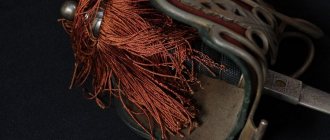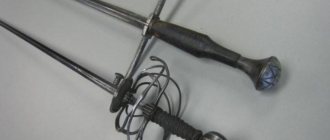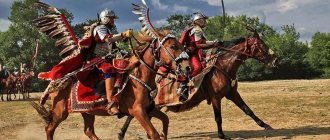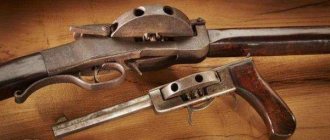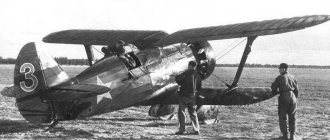The sword (English - small sword - small sword, or French - épée de cour) is a long-bladed piercing (piercing-cutting) edged weapon that came into use in the second half of the 17th century. The sword had a blade that was shorter and lighter than that of a rapier, usually of a triangular cross-section with concave edges; exceptions could be early types of swords that had flat rapier blades, or standard swords designed for the military.
Noble swords of the 18th century
Sword hilt
A typical sword hilt consisted of a hilt, a crosspiece, an arch protecting the fingers, a pas d'ane (finger rings located above the crossguard), a double shield (or, less commonly, a single plate) and a pommel.
The structure of the sword hilt
As can be seen from the image, the structure of the sword hilt is similar in general details to the rapier hilt. The main differences are that the guard and handle have become significantly smaller. The guard has lost additional protective rings and the front crosspiece.
Evolution of the sword hilt
From the end of the 17th century. and until the end of the 18th century. The hilt of the sword has undergone a number of changes, especially with regard to the dimensions of the pas d'ane:
- A - 1670 - 1680;
- B - 1700;
- C - 1700 - 1710;
- D - 1720;
- F - 1750;
- G - 1760;
- H - 1780;
- I - 1790;
It can be noted that throughout the entire 18th century the size of the pas d'ane changed; if at the beginning of the century and its first half the finger arches were large and easy to grip, then by the 70s and 80s they turned into tiny holes. Traditionally, pas d'ane, for another half a century, was attached to swords, regardless of whether they were convenient for gripping by hand or not.
Typological review of classical swords
According to the classification of Evart Oakeshott, swords are divided into:
- German reitschwert (literally translated “swords of horsemen” or “swords of reiters”) are intended for military use and are quite heavy for chopping blows (in fact, these blades are often called “combat swords” by Russian-language sources). This type of sword (along with this, it is also a sword) was the most popular among cavalrymen in the 16th century, but in the 17th century it was replaced by sabers and broadswords;
- French rapiere (from the Spanish espadas roperas - literally translated as "swords for dresses") - are intended to be worn with civilian clothing and are excessively light for slashing. However, the classic (non-sports) version of such swords has a blade. This type of sword was the most popular in the 16th century; in the 17th century it was gradually replaced by lighter swords;
- English smallswords (literally translated “small swords”, named as a contrast to the medieval “big swords” in English greatsword) differ from rapiers in having even lighter blades.
According to Oakeshott's typology, sword hilts of the 16th century are divided into:
- One-quarter;
- Half;
- Three-quarter;
- Full.
Currently, swords, as a type of military weapon, can be considered solely as a historical and artistic value; moreover, fencing is still considered one of the most dynamically developing sports with excellent entertainment value.
Sword blades
The main difference between rapiers and épées is the length and shape of the blade. At first, swords were equipped with rapier blades, but significantly shortened. However, in the last third of the 17th century, new blades appeared with a cross-section in the shape of an isosceles triangle. The triangular cross-section of the blade made it possible to make the weapon lighter while maintaining its rigidity. Judging by the earliest samples, they could deliver both piercing and chopping blows. By the beginning of the 18th century, swords with triangular blades became narrower and lost their blades, turning into exclusively piercing weapons. Triangular blades became a kind of standard that gunsmiths followed throughout the 18th century.
Sword with a flat blade
Despite the above, it is worth noting that throughout the entire period of their popularity, swords had a variety of blade shapes. Along with triangular ones, there were also flat, double-edged blades, and those with only one blade (as a rule, these are statutory swords of the late 18th century).
Features of the sword
When the sword was distributed, it was clearly accepted as a noble weapon. This was facilitated by both the combat and technical characteristics of this type of bladed weapon.
Unlike inexpensive broadswords and sabers, the soft metal of the blades, which could be compensated by the weight and force of the blow, the sword is a weapon of technology and high-quality metal.
A thinner blade required elastic and hard steel.
In addition, its focus on thrusting made the sword an even more demanding weapon in terms of production quality. For this reason, the sword became a distinctive feature of the nobility; classes with less financial means preferred cheaper sabers and swords.
In addition, owning a sword required certain skills that only warriors, who were originally nobles, could have. After fencing became a science, national schools of using these weapons gradually began to develop.
They largely depended on the characteristics of the guard and blade. Italian swords, for example, are designed for piercing blows, and practically do not use chopping and cutting, with a pull, blows of the blade. Accordingly, the handles and hilts of Italian bladed weapons are designed specifically for thrusting; chopping with them is not particularly convenient.
Also interesting is the French school, also designed for thrusting; the French type sword has a light Flemish or cavalry type guard and usually a faceted blade. Therefore, musketeer swords have a relatively short blade and an open guard.
The German school, on the contrary, uses a full range of strokes. Chopping, piercing and cutting, as well as stunning, with a flat blade. It was in the German principalities that the tactics of fighting with a dagger for the second hand - the daga - appeared.
Distreza, the Spanish school of fencing involved a whole science, including the philosophy of blade fighting. But at the same time, unlike the developing French and Italian schools, it was more conservative.
Types of swords
While changes were taking place in the hilt, the sword itself gradually became thinner and lighter. Apparently, this process of reducing the weight of the triangular blade took place in two stages. The sword blade of the late 17th century, although much lighter than the rapier blade, is still relatively heavy at the tip. Between the 1680s and 1690s, first in France, then in Germany and England, a blade known as colichemarde came into fashion - a very poor phonetic version of the name Konigsmark, pronounced in the French manner. That was the name of the Swedish count, who is considered its creator.
Colishmard
For a kolishmard, the blade is typically very wide in the strong part compared to the weak part.
The change is very abrupt; the blade is not flexible and wide at the hilt, suddenly becoming very thin in the middle part. By the end of the first quarter of the 18th century. Kolishmard is gradually falling out of use. It was replaced by a blade that became evenly smaller from base to tip. The advantages afforded by a light point were too important to be neglected, and as a result the whole blade began to be made very thin. It hasn't changed much since then.
Noble sword of the 18th century
In the 80s XVIII century statutory samples of swords began to be created. Infantry and cavalry types of these weapons were developed. A special type has emerged - the uniform sword of civilian officials; in some countries, military officers, diplomats and other officials still use the sword as part of the uniform.
Infantry officer's sword
The infantry officer's sword, model 1798, is a statutory officer's weapon introduced into use in the infantry units of the Russian army under Emperor Paul I.
History of the sword
The sword is a further historical development of the sword. This statement does not mean at all that it is a better weapon than the good old sword, just that at the time of its appearance it was more suitable for the changed conditions of warfare. On medieval battlefields the sword would have been useless, but already in the Renaissance it proved to be a very effective combat tool.
The sword can be called the same age as a firearm. Moreover, the birth of these weapons is associated with the widespread use of guns and artillery on European battlefields. Today there are several hypotheses regarding the reasons for the emergence of these weapons.
Some authors believe that the sword appeared in response to the further improvement of plate armor, which became practically invulnerable to slashing blows. They say that using a thin blade, it was possible to hit an enemy in heavy armor, delivering piercing blows to their joints. In theory, this may look nice, but in reality it seems almost impossible. The so-called Maximilian armor had a degree of protection not inferior to modern spacesuits for deep-sea diving. Hitting an enemy protected by such armor in a real fight is extremely problematic.
Another theory seems more plausible, according to which swords did not appear to pierce heavy armor, but because due to the advent of firearms, heavy armor gradually became a thing of the past. There was no point in carrying an incredible amount of iron on oneself if it could not protect the fighter from a flying bullet. The heavy swords of the late Middle Ages were precisely designed to pierce such armor; after the reduction of defensive weapons, they also became unnecessary. At this moment the sword began its triumphal march.
It should be said that the early heavy sword was not much different from the medieval sword; it was somewhat lighter and more elegant. Even additional protection for the swordsman's hand could be found on swords of an earlier period. True, fencing technique, sharpened for piercing blows, led to a change in the grip of the weapon. To make it more manageable, the index finger rested on top of the cross and needed additional protection. In addition, at the same time, plate metal gloves went out of use, which interfered with the normal use of firearms. So gradually the handle of the sword turned into that complex structure by which it can be unmistakably recognized among other bladed weapons.
It is believed that the first swords appeared in Spain around the middle of the 15th century. This weapon very quickly became popular among the noble class. Swords were lighter than swords, so they were more convenient for everyday wear. This weapon was richly decorated to emphasize the status of the owner, but at the same time it absolutely did not lose its fighting qualities. Already during this period there was a division into military and civilian swords. By the end of the 15th century, the last variety received its own name, espadas roperas, which passed into other languages and gave its own name to the new weapon - rapier.
By the way, in most European languages there is no term for “sword”. This weapon was (and is) called “sword”. In Spanish it is espada, in French it is épée, in English it is sword, and only the Germans gave the sword its own name - Degen. Moreover, in German Degen also means dagger, which gave some researchers reason to believe that it was the predecessor of the sword.
The sword gradually spread to all types of troops, finally replacing the sword. The 18th century can be called the heyday of these weapons, then they gradually began to be forced out of the army by broadswords and sabers.
Civilian swords were lighter and narrower than military weapons; often only their tip was sharpened. At the end of the 17th century in France, a short civilian sword came into use, which, due to its light weight, made it possible to carry out masterly movements with the blade. This is how the French school of fencing appeared. At this time, the rapier and sword become practically indistinguishable from each other and completely lose their chopping function. The decrease in the mass of the sword occurred not only due to a decrease in its length and width, but also due to the fact that the blade became faceted. This is how a light civilian sword appeared, which survived until the beginning of the 20th century without much change.
The most popular were three-edged blades, although there were also examples with six edges. Initially, the blades were made wide at the hilt; it is believed that this part of the sword was intended to parry enemy blows. The classic narrow shape of the sword finally acquired by the era of the Napoleonic wars. We can say that from this moment the evolution of the sword ended.
It should also be said that the light civilian sword became the prototype of the modern sports rapier, and the basic techniques of sports fencing are based on the techniques of the French school.
The civilian sword was an extremely popular weapon. It was worn by nobles, bourgeois, military men in peacetime and even students. Wearing a sword was a privilege for them; students usually received swords after graduation, but there were exceptions. For example, students at Moscow University received the right to carry these weapons after entering the university.
German students not only enjoyed wearing swords, but also loved to use them in duels. Moreover, young men in Prussia were extremely proud of the scars they received in such battles. Sometimes they were specially rubbed with gunpowder so that the mark would remain for life.
In Russia, they tried to equip more rifle units with swords, but this weapon did not catch on. Later they began to use it en masse in units of the new system, and Peter the Great armed all Russian infantry with swords. But then the sword was replaced by a half-saber among the rank and file. The sword was left only to the officer corps and guards musketeers. In their design, Russian swords were no different from their foreign counterparts.
In the 19th century, swords in the Russian army lost their importance as military weapons and were gradually replaced by sabers. However, officers continue to carry them outside of formation, as a ceremonial weapon. Until 1917, the sword was the weapon of generals and officers of cuirassier regiments outside the ranks, in addition, it was worn by civil officials as an element of ceremonial clothing.
Fencing with swords
In the second half of the 17th century. A new school of fencing arose in France. The French masters focused not on the mobility of the fighter, but on the mobility of the weapon itself - it became lighter and shorter, which made it more maneuverable and easier to control. All this made it possible to deliver lightning-fast, jewelry-precise injections. Complex combinations of feints, changes of position and lines of attack turned fencing into a kind of chess game.
Fencing with swords
In the hands of an experienced fighter, a short and thin sword turned into a formidable weapon. The French fencing school quickly gained leadership. A new type of sword soon replaced long and uncomfortable rapiers.

